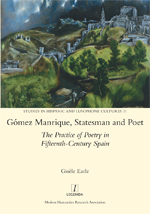Gómez Manrique, Statesman and Poet
The Practice of Poetry in Fifteenth-Century Spain
Gisèle Earle
Click cover to enlarge Buy hardback at: Buy paperback at: Booksellers & libraries: | Studies in Hispanic and Lusophone Cultures 31 Legenda 26 February 2018 • 182pp ISBN: 978-1-781885-81-9 (hardback) • RRP £80, $110, €95 ISBN: 978-1-781885-82-6 (paperback, 5 November 2019) • RRP £10.99, $14.99, €13.49 ISBN: 978-1-781885-83-3 (JSTOR ebook) Access online: Books@JSTOR MedievalSpanishPoetrystudent-priced In addition to its original library hardback edition, this title is now on sale in the new student-priced Legenda paperback range. Gómez Manrique (c.1412-c.1490) had a long and active life, engaging in military activity as a typical medieval knight before becoming a diplomat and statesman. He was deeply involved in the political turbulence of fifteenth-century Castile, playing an important role in bringing together Fernando of Aragon and the infanta Isabel of Castile whose marriage sealed the union of these two kingdoms. Although Don Gómez has long rested in the shadow of his more famous nephew, Jorge, he produced a larger and more varied corpus of verse: courtly love poetry, elegies, moral and political poetry, verse dialogues with friends, consolatory poems and the first play by a known author in Spanish. This study focuses on the social, economic and political context in which the poet lived and draws comparisons with some other poets who were his contemporaries. Gisèle Earle studied at the University of Oxford and King’s College, London, and is now an independent researcher. Reviews:
Contents:
Bibliography entry: Earle, Gisèle, Gómez Manrique, Statesman and Poet: The Practice of Poetry in Fifteenth-Century Spain, Studies in Hispanic and Lusophone Cultures, 31 (Legenda, 2018) First footnote reference: 35 Gisèle Earle, Gómez Manrique, Statesman and Poet: The Practice of Poetry in Fifteenth-Century Spain, Studies in Hispanic and Lusophone Cultures, 31 (Legenda, 2018), p. 21. Subsequent footnote reference: 37 Earle, p. 47. (To see how these citations were worked out, follow this link.) Bibliography entry: Earle, Gisèle. 2018. Gómez Manrique, Statesman and Poet: The Practice of Poetry in Fifteenth-Century Spain, Studies in Hispanic and Lusophone Cultures, 31 (Legenda) Example citation: ‘A quotation occurring on page 21 of this work’ (Earle 2018: 21). Example footnote reference: 35 Earle 2018: 21. (To see how these citations were worked out, follow this link.) This title is distributed on behalf of MHRA by Ingram’s. Booksellers and libraries can order direct from Ingram by setting up a free ipage® Account: click here for more. Permanent link to this title: www.mhra.org.uk/publications/Gómez-Manrique-Statesman-Poet www.mhra.org.uk/publications/shlc-31 | ||||||||||||||||||||||||||||||||||||||||||||||||||||||||||||||||||

